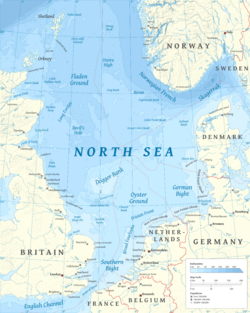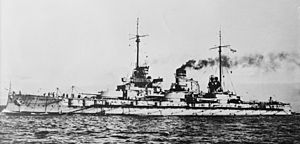Action of 19 August 1916 facts for kids
Quick facts for kids Action of 19 August 1916 |
|||||||
|---|---|---|---|---|---|---|---|
| Part of the First World War | |||||||
 Map of the North Sea |
|||||||
|
|||||||
| Belligerents | |||||||
| Commanders and leaders | |||||||
| Strength | |||||||
| 29 battleships 6 battlecruisers 5 armoured cruisers 26 light cruisers 70 destroyers 1 minelayer 1 seaplane carrier 1 submarine |
18 battleships 2 battlecruisers 7 light cruisers 56 torpedo boats 2 Zeppelins 3 submarines |
||||||
| Casualties and losses | |||||||
| 39 killed 2 light cruisers sunk |
1 battleship damaged | ||||||
The Action of 19 August 1916 was a naval event during the First World War. It was one of two times in 1916 that the German High Seas Fleet tried to fight parts of the British Grand Fleet. This happened after the Battle of Jutland, which had mixed results for both sides.
After Jutland, Germany learned that scouting was very important. They needed to know where British ships were. So, eight Zeppelin airships were sent to look for British ships. Twenty-four German submarines also watched the English coast and the North Sea.
Why Did the Fleets Meet?
The Germans said they won the Battle of Jutland (May–June 1916). But their fleet was badly damaged. Admiral Reinhard Scheer, who led the High Seas Fleet, wanted another raid. He hoped it would keep his sailors' spirits high.
German Plan: Bombard Sunderland
The plan was like earlier raids. German battlecruisers would attack an English town at dawn. This time, the target was Sunderland. Only two battlecruisers, Moltke and Von der Tann, were ready after Jutland. So, three battleships, Bayern, Markgraf and Grosser Kurfürst, joined them.
The rest of the High Seas Fleet, with 15 powerful battleships, would follow close behind. They sailed from the Jade River on the evening of August 18.
How the Fleets Prepared
British Intelligence Gets a Tip
British Naval Intelligence, known as Room 40, found out about the German plan. They did this by intercepting and decoding German radio messages.
Admiral Sir John Jellicoe, who led the Grand Fleet, was on leave. He was quickly called back. He boarded a light cruiser to meet his fleet early on August 19.
British Ships Set Sail
Before Jellicoe arrived, Admiral Cecil Burney took the fleet to sea. Vice-Admiral David Beatty also sailed with his battlecruisers. They were going to meet the main fleet.
The British also sent out 20 destroyers and five light cruisers. Twenty-five British submarines were placed in areas where German ships might pass.
First Loss: HMS Nottingham
The British battlecruisers and five fast battleships were scouting ahead. They were looking for the German fleet. But one of their light cruisers, HMS Nottingham, was hit. It was struck by three torpedoes from the German submarine U-52. The ship sank at 6:00 a.m.
Jellicoe's Decisions
At 6:15 a.m., Jellicoe learned from the Admiralty that the enemy was to his southeast. The loss of Nottingham made him worried. He first headed north to protect his other ships. He wasn't sure if it was a submarine or a mine.
He didn't turn southeast again until 9:00 a.m. By then, he knew it was a submarine attack. More information suggested his battlecruisers would be close to the German fleet by 2:00 p.m. Jellicoe ordered maximum speed. The weather was good, and there was still time for a big battle.
German Fleet Changes Course
The German force got some good news about Jellicoe's position. A Zeppelin saw the Grand Fleet heading north, away from Admiral Scheer. This was when Jellicoe was avoiding the possible minefield.
Another Zeppelin spotted the British Harwich force. It mistakenly thought the cruisers were battleships. This was the kind of target Scheer wanted. So, he changed course at 12:15 p.m., also heading southeast. This took him away from the main British fleet.
No more reports came from Zeppelins about the British fleet. But a German U-boat spotted it north of Scheer. The High Seas Fleet then turned for home at 2:35 p.m., giving up on this target. By 4:00 p.m., Jellicoe learned that Scheer had left. So, he also turned north.
More Attacks and a Damaged Battleship

Another British cruiser, HMS Falmouth, was hit. It was struck by two torpedoes from U-66 at 4:52 p.m. Falmouth tried to get to Humber, escorted by destroyers. A tugboat arrived to help tow the ship.
But the ship's path took it near a line of U-boats. At noon, Falmouth was hit again by two torpedoes from U-63. The ship stayed afloat for eight more hours but then sank.
Meanwhile, the British submarine HMS E23 hit the German battleship SMS Westfalen. This happened north of Terschelling at 5:05 a.m. on August 19. But the German ship was still able to reach port.
What Happened Next?
On September 13, Jellicoe and other naval leaders met. They talked about what had happened. They decided it was too risky to operate the fleet too far south in the North Sea. This was because of the danger from submarines and mines.
Jellicoe felt they didn't have enough destroyers to protect the fleet further south. The Admiralty agreed with these conclusions.
Admiral Scheer was not happy with his Zeppelin scouts. Only three of them saw anything, and four of their seven reports were wrong.
End of Deep North Sea Raids
This was the last time the German fleet sailed so far west into the North Sea. On October 6, Germany started using submarines to attack merchant ships again. This meant their U-boat fleet was no longer available for big attacks with surface ships.
Later, in October, Scheer led a short trip into the North Sea. British intelligence knew about it. But the Grand Fleet stayed in port, ready to sail if needed. The German trip ended quickly when SMS München was hit by a torpedo from E38. They feared more submarines were around.
Scheer had more problems in November. He sailed to rescue two stranded U-boats. But British submarine J1 managed to hit two German battleships. These failures showed that big fleet operations were too risky. The danger from submarines and mines was too great.
See Also


